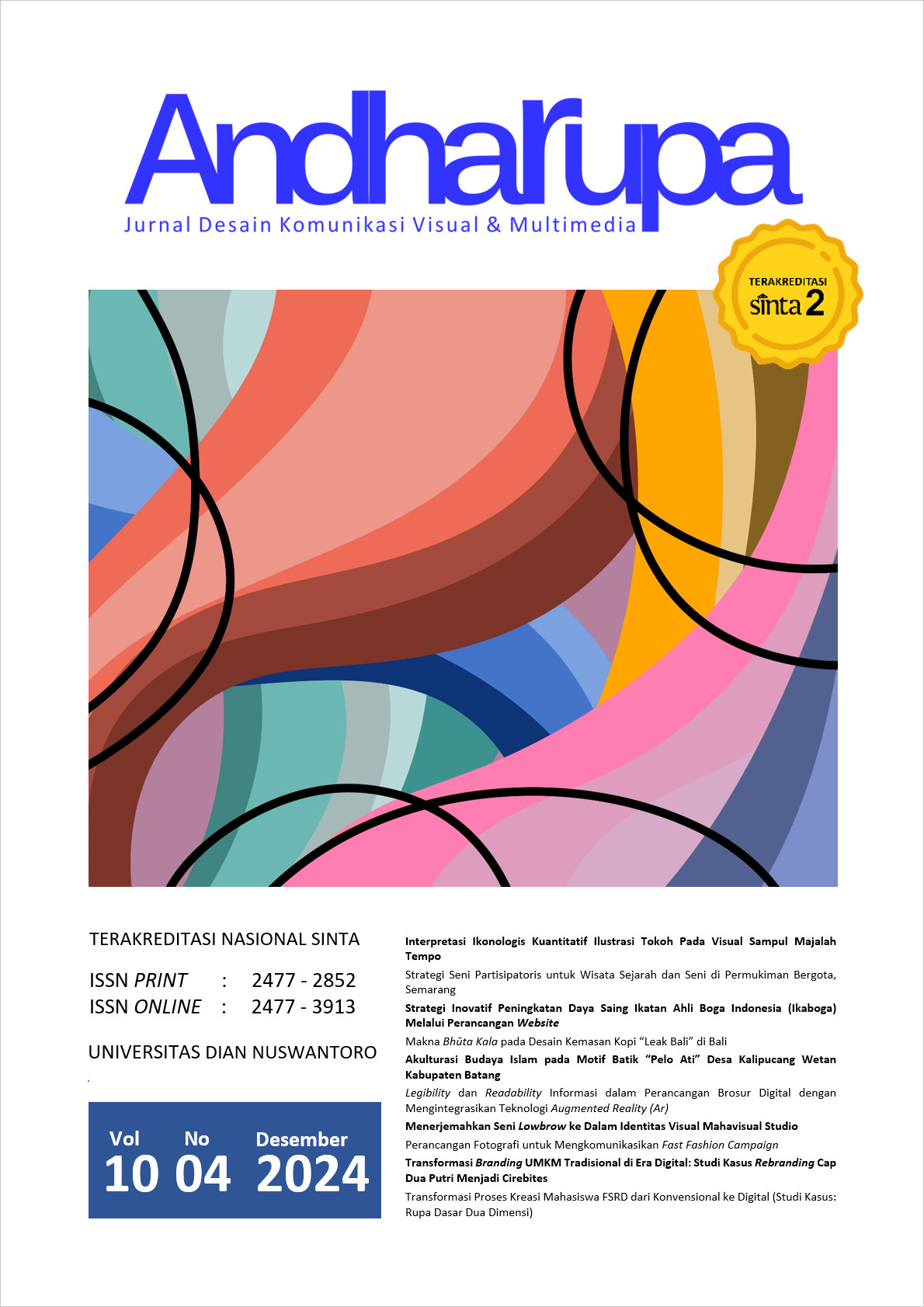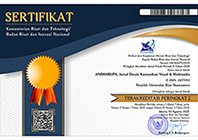INTERPRETASI IKONOLOGIS KUANTITATIF ILUSTRASI TOKOH PADA VISUAL SAMPUL MAJALAH TEMPO
DOI:
https://doi.org/10.33633/andharupa.v10i04.9067Keywords:
Kuantitatif, Interpretasi Ikonologis, Neural Networks, Majalah TempoAbstract
Interpretasi ikonologis kuantitatif terhadap ilustrasi tokoh pada visual sampul majalah Tempo akan melibatkan analisis elemen-elemen visual dalam28 edisi penerbitan dengan durasi januari hingga agustus 2023 pendekatan dalam analisis seni visual yang fokus pada makna simbolis dan konteks seperti objek subjek, dan teman visual apa yang di tampilkan identifikasi tokoh utama yang muncul pada sampul majalah. Tokoh ini bisa menjadi pusat perhatian dalam ilustrasi dan dapat berupa figur publik, politisi, selebriti, atau tokoh yang saat itu sedang populer atau relevan dalam isu yang dibahas dan Komposisi Umum: Evaluasi keseluruhan komposisi ilustrasi, termasuk distribusi elemen-elemen visual, ruang kosong, dan hubungan antara tokoh dan elemen lainnya. Metode penelitian menggunakan analisis statistik kuantitatif frekuensi dan neural networks yang merupakan narasi numerik dari tabel kualitatif. Analisis kuantitatif terhadap elemen-elemen visual, focus pada dependent variable tema visual antara lain satire, personifikasi, ironi, gambar metafora, parodi, deskriptif kesimpulan yang di dapat melalui pendekatan ini, menunjukan interpretasi ikonologis kuantitatif dapat memberikan pemahaman yang lebih dalam tentang pesan dan konteks yang terkandung dalam ilustrasi tokoh pada visual sampul majalah Tempo.References
Abrahamson, D., & Prior-Miller, M. R. (2015). The Routledge Handbook of Magazine Research: The Future of the Magazine Form. Taylor & Francis. https://books.google.co.id/books?id=8EHLCQAAQBAJ
Ahdiyat, A. N. (2021). Analisis Semiotika Visual Pada Ilustrasi Sampul Majalah Tempo Edisi “Jerat Kedua.” Logika : Jurnal Penelitian Universitas Kuningan, 12(2), 156–175. https://doi.org/10.25134/logika.v12i2.5492
Al-Badi, A., & Khan, A. I. (2022). A Sustainable Development Neural Network Model for Big Data in Smart Cities. International Conference on Identification, Information and Knowledge in the Internet of Things, 2021, 202, 408–413. https://doi.org/10.1016/j.procs.2022.04.057
Baroncini, S., Daquino, M., & Tomasi, F. (2021). Modelling Art Interpretation and Meaning. A Data Model for Describing Iconology and Iconography. ArXiv, 1–16. https://doi.org/10.48550/arXiv.2106.12967
Baroncini, S., Sartini, B., Van Erp, M., Tomasi, F., & Gangemi, A. (2023). Is dc:subject enough? A landscape on iconography and iconology statements of knowledge graphs in the semantic web. Journal of Documentation, 79(7), 115–136. https://doi.org/10.1108/JD-09-2022-0207
Behshad, A., & Ghaniabadi, S. (2015). Visual Analysis of Magazine Covers. International Journal of Linguistics, 7(6), 20–32. https://doi.org/doi:10.5296/ijl.v7i5.8445
Christensen, A. P., Cardillo, E. R., & Chatterjee, A. (2023). What kind of impacts can artwork have on viewers? Establishing a taxonomy for aesthetic impacts. British Journal of Psychology, 114(2), 335–351. https://doi.org/10.1111/bjop.12623
Dupraz, E. (2023). Childhood Iconography in Humanitarian Aid: A comparative analysis to understand the academic discourse generated by visual representations of suffering children: The Use of Childhood Iconography in Humanitarian Aid: Vol. Independent thesis Advanced level (degree of Master (One Year)) [Student thesis]. DiVA. http://urn.kb.se/resolve?urn=urn:nbn:se:uu:diva-503280
Fayaz, M., Meraj, G., Khader, S. A., & Farooq, M. (2022). ARIMA and SPSS statistics based assessment of landslide occurrence in western Himalayas. Environmental Challenges, 9, 100624. https://doi.org/10.1016/j.envc.2022.100624
Grittmann, E. (2018). Grounded Theory und qualitative Bildanalyse. In C. Pentzold, A. Bischof, & N. Heise (Eds.), Praxis Grounded Theory: Theoriegenerierendes empirisches Forschen in medienbezogenen Lebenswelten. Ein Lehr- und Arbeitsbuch (pp. 191–210). Springer Fachmedien Wiesbaden. https://doi.org/10.1007/978-3-658-15999-3_9
Kachorsky, D., Reid, S. F., & Chapman, K. (2020). Education Through TIME: Representations of U.S. Education on TIME Magazine Covers. AERA Open, 6(3), 2332858420961110. https://doi.org/10.1177/2332858420961110
Kencana, W. H. (2020). Analisis Ilustrasi Sosok Jokowi Dalam Penanganan Pandemi Covid-19 Pada Sampul Majalah Tempo. MEDIALOG: Jurnal Ilmu Komunikasi, 3(3), 52–64. https://doi.org/10.35326/medialog.v3i2.786
Lee-Merrion, H. (2020, June 1). An introduction to conceptual and editorial illustration. Https://Www.Harrietleemerrion.Com. https://www.harrietleemerrion.com/blog/2020/6/1/what-is-conceptual-and-editorial-illustration
Llorella, F. R., Azorín, J. M., & Patow, G. (2023). Black hole algorithm with convolutional neural networks for the creation of brain-computer interface based in visual perception and visual imagery. Neural Computing and Applications, 35(8), 5631–5641. https://doi.org/10.1007/s00521-022-07542-5
Martikainen, J. (2019). Social Representations of Teachership Based on Cover Images of Finnish Teacher Magazine: A Visual Rhetoric Approach. Journal of Social and Political Psychology, 7(2), 890–912. https://doi.org/10.5964/jspp.v7i2.1045
Meisner, M. S., & Takahashi, B. (2014). The Nature of Time: How the Covers of the World’s Most Widely Read Weekly News Magazine Visualize Environmental Affairs. In Visual Environmental Communication (1st ed., Vol. 7, p. 22). Routledge. http://dx.doi.org/10.1080/17524032.2013.772908
Ningtyas, D. A., Haikal, H., Ariska, Y., & Kusnadi, E. (2023). Makna Karikatur Cover Majalah Tempo Edisi September 2019 Studi Semiotika Roland Barthes. Jurnal Media Penyiaran, 3(1), 8–16. https://doi.org/10.31294/jmp.v3i01.1934
Panofsky, E., & Smith, J. C. (2023). The Life and Art of Albrecht Dürer. Princeton University Press. https://books.google.co.id/books?id=InDCEAAAQBAJ
Pérez-Núñez, P., Díez, J., Remeseiro, B., Luaces, O., & Bahamonde, A. (2023). All-in-one picture: Visual summary of items in a recommender system. Neural Computing and Applications. https://doi.org/10.1007/s00521-023-08822-4
Rahardjo, B. A., Ari, I. A. D. K., & Nuriarta, I. W. (2020). Kajian Semiotika Sampul Majalah Tempo Edisi Covid-19. AMARASI: JURNAL DESAIN KOMUNIKASI VISUAL, 1(2). https://doi.org/10.59997/amarasi.v1i02.36
Sartini, B., Baroncini, S., van Erp, M., Tomasi, F., & Gangemi, A. (2023). ICON: An Ontology for Comprehensive Artistic Interpretations. J. Comput. Cult. Herit., 16(3). https://doi.org/10.1145/3594724
Sercu, L. (2022). Can popular magazines educate people with depression? An investigation of articles’ understandability, reliability, and actionability. PEC Innovation, 1, 100099. https://doi.org/10.1016/j.pecinn.2022.100099
Seyidoglu, J., Roberts, C., Darroch, F., Hillsburg, H., Schneeberg, A., McGettigan-Dumas, R., Huddle, M., & Montaño, A. (2022). Racing for Representation: A Visual Content Analysis of North American Running Magazine Covers. Communication & Sport, 10(4), 642–663. https://doi.org/10.1177/21674795211000325
Spinner, L., Cameron, L., & Tenenbaum, H. R. (2023). Gender Stereotypes in Young Children’s Magazines. Mass Communication and Society, 26(1), 147–170. https://doi.org/10.1080/15205436.2022.2052902
Sugono, D. (2016). Media Penyebar/Penerbit Sastra: Tempo [Gov]. Ensiklopedia Sastra. https://ensiklopedia.kemdikbud.go.id/sastra/artikel/Tempo
Targia, G. (2023). Writing images as an act of interpreting: Notes on Erwin Panofsky’s studies on medieval subjects and the problem of language in and of art history. Word & Image, 39(1), 88–98. https://doi.org/10.1080/02666286.2023.2168472
Tempo Media Group. (2019). Tempo mencanangkan tahun ini sebagai Total Transformasi Digital. [News]. Https://Www.Tempo.Id. https://www.tempo.id/corporate.php#sejarah
Tseronis, A. (2015). Multimodal argumentation in news magazine covers: A case study of front covers putting Greece on the spot of the European economic crisis. Discourse, Context & Media, 7, 18–27. https://doi.org/10.1016/j.dcm.2014.12.003
Wahyudi, L., & Purnomo, A. S. A. (2022). Analisis Semiotika Pada Ilustrasi Sampul Majalah Tempo Bertema Terorisme Edisi 13 – 27 Mei 2018. JURNAL BAHASA RUPA, 5(2), 208–218. https://doi.org/10.31598/bahasarupa.v5i2.1066
Yudhanto, S. H., Risdianto, F., & Artanto, A. T. (2023). Cultural and Communication Approaches in the Design of Visual Communication Design Works. International Journal of Linguistics, Culture and Communication, 1(1), 79–90.
Downloads
Published
Issue
Section
License
Copyright (c) 2024 ANDHARUPA: Jurnal Desain Komunikasi Visual & Multimedia

This work is licensed under a Creative Commons Attribution 4.0 International License.
Authors who publish with this journal agree to the following terms:
- Authors retain copyright and grant the journal right of first publication with the work simultaneously licensed under a Creative Commons Attribution License that allows others to share the work with an acknowledgment of the work's authorship and initial publication in this journal.
- Authors are able to enter into separate, additional contractual arrangements for the non-exclusive distribution of the journal's published version of the work (e.g., post it to an institutional repository or publish it in a book), with an acknowledgment of its initial publication in this journal.
- Authors are permitted and encouraged to post their work online (e.g., in institutional repositories or on their website) prior to and during the submission process, as it can lead to productive exchanges, as well as earlier and greater citation of published work (See The Effect of Open Access).















